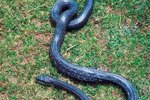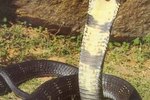
The South American rain forest—60 percent of which lies within Brazilian borders—is home to over 400 species of reptiles, over 100 of them being snakes. While many rain forest snake species remain unclassified, scientists have identified hundreds of snakes in four major categories that inhabit the Amazon rain forest.
Constrictors
The anaconda is the biggest and best-known constrictor snake in the Brazilian rain forest. The massive yellow and green anacondas can grow up to 30 feet long and are capable of killing and eating prey the size of an adult human. Other constrictors common to the Brazilian rain forest include the boa constrictor, the rainbow boa, the emerald tree boa and the common tree boa. These constrictors generally reach lengths of 5 to 6 feet.
Vipers
Brazilian rain forest vipers are all classified by their triangular heads, which is about the only thing they all have in common. Tropical viper snakes range in size, live in diverse habitats and have a wide range of different diets. The fer-de-lance is one of the most venomous vipers in the Brazilian rain forest, while the bushmaster is the largest, reaching 12 feet in length.
Elapids
Elapids are the most venomous snakes in the world. These long-fanged, extremely poisonous snakes are found on all continents. In the rain forest, deadly coral snakes lie in wait under stones and leaves on the forest floor. In 2010, the World Wildlife Fund reported that two new elapid snake species, similar to the deadly cobra and taipan species, had been discovered in the Amazon rain forest.
Innocuous Snakes
The Brazilian rain forest is home to dozens of innocuous snakes that pose no danger to humans. Some are large, some are small, and all are carnivorous (as all snakes are). Small tree snakes and colorful lowland snakes are abundant in the tropical rain forest habitat.
References
Resources
Photo Credits
-
Thomas Northcut/Lifesize/Getty Images
Writer Bio
Debra Pachucki has been writing in the journalistic, scholastic and educational sectors since 2003. Pachucki holds a Bachelor's degree in education and currently teaches in New Jersey. She has worked professionally with children of all ages and is pursuing a second Masters degree in education from Monmouth University.




